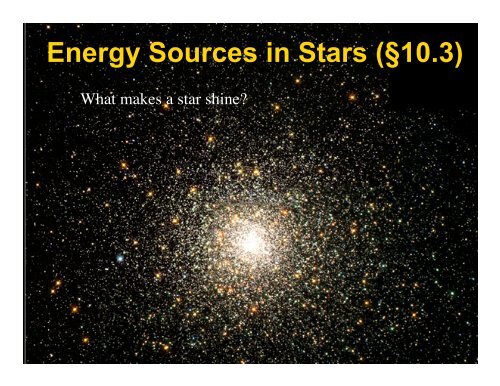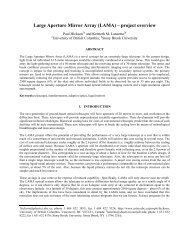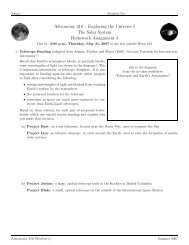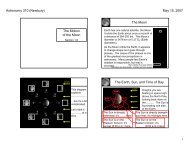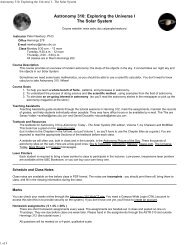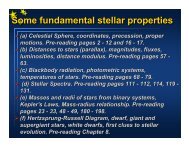Energy Sources in Stars (§10.3)
Energy Sources in Stars (§10.3)
Energy Sources in Stars (§10.3)
You also want an ePaper? Increase the reach of your titles
YUMPU automatically turns print PDFs into web optimized ePapers that Google loves.
<strong>Energy</strong> <strong>Sources</strong> <strong>in</strong> <strong>Stars</strong> (§10.3)What makes a star sh<strong>in</strong>e?
<strong>Energy</strong> <strong>Sources</strong> <strong>in</strong> <strong>Stars</strong> (§10.3)What makes a star sh<strong>in</strong>e?Sun’s s <strong>Energy</strong> OutputL sun = 4 x 10 26 W (J s -1 )sun 4.5 x 10 9 yr (1.4 x 10 17 s) - oldest rocks - radioactive dat<strong>in</strong>gt sunL sun ~ constant over geological timescale (fossil evidence)Therefore total energy output E tot = L sun x t sun = 6 x 10 43How might the Sun have generated this energy?43 J
<strong>Energy</strong> <strong>Sources</strong> <strong>in</strong> <strong>Stars</strong><strong>Energy</strong> Source #3:Nuclear <strong>Energy</strong>Fission?Z = 0.02 (2% Sun consists of heavy elements).Fissionable isotopes like 235 U are rare (isotopes are nucleiiwith the same # protons but different # neutrons)Fusion?e.g. 4 protons get converted <strong>in</strong>to 2p + 2n i.e. i4H → 1 4 HeH is very abundant <strong>in</strong> the Sun (X = 0.73)4 H nuclei: mass = 4 x m p = 6.693 x 10 -27 kg1 4 He nucleus: mass = 6.645 x 10 -27 kg (b<strong>in</strong>d<strong>in</strong>g energy <strong>in</strong>cluded)Difference is 0.048 x 10 -27 kg = 0.7% of orig<strong>in</strong>al massWhere does this mass go?
<strong>Energy</strong> <strong>Sources</strong> <strong>in</strong> <strong>Stars</strong><strong>Energy</strong> Source #3:Nuclear <strong>Energy</strong>The “lost” mass is converted <strong>in</strong>to energy accord<strong>in</strong>g to E<strong>in</strong>ste<strong>in</strong>’sequation for the rest energy of matter: E = mc 2 (E energy, mmass, c speed light)Example:Suppose that Sun was orig<strong>in</strong>ally 100% H and only 10% of that wasavailable for fusion. Thus…M H available = 0.1 M sunΔM H destroyed through fusion = 0.1 M sun x 0.007total nuclear energy available E tot = (7 x 10 -4 M sun )c 2 ~ 1.3 x 10 44Sun’s s total lifetime energy output = 6 x 10 43 JE tot ~ 2 x the total energy Sun has emitted!!→ Sun could sh<strong>in</strong>e for at least another 5 x 10 9 yr at its current lum<strong>in</strong>osityHence t nuclear for Sun ~ 10 10 yrs44 J
<strong>Energy</strong> <strong>Sources</strong> <strong>in</strong> <strong>Stars</strong><strong>Energy</strong> Source #3:Nuclear <strong>Energy</strong>Fission?Z = 0.02 (2% Sun consists of heavy elements).Fissionable isotopes like 235 U are rare (isotopes are nucleiiwith the same # protons but different # neutrons)Fusion?e.g. 4 protons get converted <strong>in</strong>to 2p + 2n i.e. i4H → 1 4 HeH is very abundant <strong>in</strong> the Sun (X = 0.73)4 H nuclei: mass = 4 x m p = 6.693 x 10 -27 kg1 4 He nucleus: mass = 6.645 x 10 -27 kg (b<strong>in</strong>d<strong>in</strong>g energy <strong>in</strong>cluded)Difference is 0.048 x 10 -27 kg = 0.7% of orig<strong>in</strong>al massWhere does this mass go?
Can Fusion Occur <strong>in</strong> Sun’s s Core?Protons must overcome mutual electrostatic repulsion: CoulombBarrierClassical Approach: E k<strong>in</strong> proton > E coulomb 1/2 m p v 2 > e 2 /r (cgs(form) LHS is thermal gas energy,thus, 3/2 kT >e 2 /r At T central ~ 1.6 x 10 7 K → E k<strong>in</strong>~ 3.3 x 10 -16 J For successful fusion, r ~10 -15 m (1 fm) →E coulomb ~ 2.3 x 10 -13 J E k<strong>in</strong> ~ 10 -3 E coulombClassically, would need T~10 10 to overcome Coulomb barrierSo, no Fusion??
Can Fusion Occur <strong>in</strong> Sun’s s Core?Can we be helped by consider<strong>in</strong>g the distribution of energies? - notall protons will have just E th = 3/2 kTProton velocities are distributed accord<strong>in</strong>g to the Maxwellianequation: P(v) = 4π(m/24(m/2πkT)3/2 v 2 e -mv2 /2kTAt the high energy tail of the Maxwellian distribution, the relativenumber of protons, with E > 10 3 x E th is:N(E coulomb ~ 10 3 )/N() ~ e -ΔE/kt~ e -1000 = 10 -430 !!Number protons <strong>in</strong> Sun = M sun /M H ~ 10 57 so 1 <strong>in</strong> 10 430 of thesewill have enough energy to overcome Coulomb barrier.So aga<strong>in</strong>, no nuclear reactions??
Can Fusion Occur <strong>in</strong> Sun’s s Core?Even with tunnell<strong>in</strong>g, , are stars hot enough for nuclear reactions to proceed?λ = h/p is the wavelength associated with a massive particle (p = momentum)In terms momentum, the k<strong>in</strong>etic energy of a proton is:1/2 m p v 2 = p 2 /2m pAssum<strong>in</strong>g proton must be with<strong>in</strong> 1 de Broglie λ of its target to tunnelset distance, r, of closest approach to λ, (where barrier height = orig<strong>in</strong>al K.E.<strong>in</strong>com<strong>in</strong>g particle) gives:e 2 /r = e 2 /λ = p 2 /2m p = (h/λ) 2 /2m pSolv<strong>in</strong>g for λ (=h 2 /2m p e 2 ) and substitut<strong>in</strong>g r = λ <strong>in</strong>to 3/2 kT = e 2 /r, we get theQM estimate of the temperature required for a nuclear reaction to occur:QM = 4/3(e 4 m p /kh 2 ) - putt<strong>in</strong>g <strong>in</strong> numbersT QMT QMQM = 10 7 K which is comparable to T core . Therefore, fusion is feasible atcentre of Sun
Proton-Proton Cha<strong>in</strong>Basic particles <strong>in</strong>volved <strong>in</strong> nuclear reactionsParticlephotonneutr<strong>in</strong>oanti-neutr<strong>in</strong>oelectronpositronproton ( 1 1H)neutronSymbolγνν-e-e+p+nRest mass(kg)0>0>09 x 10 -319 x 10 -311.6 x 10 -271.6 x 10 -27Charge (e-)000-1+1+10Sp<strong>in</strong>11/21/21/21/21/21/2deuteron21H3.2 x 10 -27+1Conservation Laws <strong>in</strong> nuclear reactions:(1) mass-energy(2) charge(3) difference between number particles and anti-particles conserved -ie particle cannot be created from anti-particle or vice-versa but a pair can beformed or destroyed without violat<strong>in</strong>g this rule
Proton-Proton Cha<strong>in</strong>Types of nuclear reactionsBeta Decay: n → p + + e - + ν - proceeds spontaneously - also forneutron <strong>in</strong>side nucleuseg [Z-1, A] → [Z, A] + e - + ν - (Z = # p + , N = # n, A = Z+N)Inverse Beta Decay: p + + e - → n + νeg [ 13 N → 13 C + e + + ν](p + , γ) ) process: A Z + p + → A+1 (Z+1) + γeg [ 12 C + p + → 13 N + γ](α, γ) process: α particle ( 4 He) added to nucleus to make heavierparticle [ A Z + 4 He → A+4 (Z+2) + γ]eg. [ 8 Be + 4 He → 12 C + γ]
Proton-Proton Cha<strong>in</strong>S<strong>in</strong>ce the Sun’s s mass consists mostly of H and He, we anticipatenuclear reactions <strong>in</strong>volv<strong>in</strong>g these two elementsegp + + p + → 2 Hep + + 4 He → 5 Li4 He + 4 He → 8 BeBut there is a problem here - what is it?All these reactions produce unstable particlesegp + + p + → 2 He → p + + p +p + + 4 He → 5 Li → p + + 4 He4 He + 4 He → 8 Be → 4 He + 4 HeSo among light elements there are no two-particle exothermicreactions produc<strong>in</strong>g stable particles. We have to look tomore peculiar reactions or those <strong>in</strong>volv<strong>in</strong>g rarer particles
Proton-Proton Cha<strong>in</strong>Summary of proton-proton cha<strong>in</strong>:• 6p + → 4 He + 2p + + 2e + + 2ν 2 + 2γ 2 or 4p + → 4 He + 2e+ + 2ν 2 + 2γ2• Mass difference between 4p + and 1 4 He = 26.7 Mev x 6.424 x 10 18 ev/J= 4.2 x 10 -12 J• ~3% of this energy (0.8 Mev) ) is carried off by neutr<strong>in</strong>os and does notcontribute to the Sun’s s lum<strong>in</strong>osity• 2 e + immediately annihilate with 2 e - and add 2 x 0.511 Mev (= 1.02Mev)• So, the total energy available for the Sun’s s lum<strong>in</strong>osity per 4 He formedis: (26.7 - 0.8 +1.02) Mev = 26.9 Mev = 4.2 x 10 -12 J• # 4 He formed/sec = L sun /4.2 x 10 -12 J = 3.9 x10 26 J/s / 4.2x10 -12 J= 9.3 x 10 37 4 He/s• Increase of 4 He mass/time = dm He /dt = 9.3 x 10 37 4 He/s x 6.68 x 10 -27kg/ 4 He = 6.2 x 10 11 kg 4 He /sAfter 10 10 years (3 x 10 17 sec), M( 4 He) = 1.9 x 10 29 kg = 10% massSun
Proton-Proton Cha<strong>in</strong>The previous nuclearreaction cha<strong>in</strong> (PPI) is notthe only way to convert H<strong>in</strong>to He.A second branch (PPII)In solar centre, 69% of 2 3 He comb<strong>in</strong>es withanother 2 3 He, but 31% can fuse with 2 4 He32He + 4 2He " 7 4Be + #eg last step:3 He + 3 He → 4 !He + 2p +can proceed differently ifthere is appreciable 4 Hepresent!!!!!7 4Be + e " # 7 3Li + $ e73Li + p + " 4 2He + 4 2HeA third branch (PPIII)In the Sun's core, a 4 7 Be nucleus can capturea p + <strong>in</strong>stead of an e " about 0.3% of the time.4Very unstable7 Be + p + " 5 8 B + #85B " 8 4Be + e + + # e8 Be " 4 2He + 4 2He4PPI + PPII + PPIII operatesimultaneously!!
Proton-Proton Cha<strong>in</strong>: Summaryp + + p + " 1 2 H + e + + # e21H + p + " 3 2He + $69% 31%32He + 3 2He " 4 2He + 2p + 3 2He + 4 2He " 7 4Be + #!(PPI) 99.7% 0.3%!!7 4Be + e " # 7 3Li + $ e!7 Li + p + # 2 4 2He3Fraction of He 4 produced(PPII)1.00.50PPI!PPII7 4Be + p + " 8 5B + #85B " 8 4Be + e + + $ e84Be " 2 4 2He(PPIII)PPIII0 10 20 30 40T (10 6 )K)
Alternate Fusion Reactions H → 4 HeCNO Cycle (or bi-cycle)• First step <strong>in</strong> PP cha<strong>in</strong> has very lowreaction rate (weak <strong>in</strong>teraction).• 12 C can act as a catalyst <strong>in</strong> fusionreaction.• Net result:12 C + 4p + → 12 C + 4 He + 2e + + 2ν2+ 3γ3• Note: 12 C neither created nordestroyed. Also isotopes of N & Oare temporarily produced.• CNO cycle dom<strong>in</strong>ates over PPcha<strong>in</strong> if T core > 1.8 x 10 7 (slightlyhotter than Sun)THE CNO BI-CYCLE(T < 10 8 K)10 6 yr}14 m<strong>in</strong>3 x 10 5 yr3 x 10 8 yr82 s10 4 yrX as frequentlyOnce forevery 2500<strong>in</strong>stances ofCycle 1
Other Fusion ReactionsAt higher T centre , heavier nuclei can fuse to produce energyFusion of<strong>in</strong>toat T centralRef.4Hetriple α processBe, C~10 8 Kp. 31212 CO, Ne, Na, Mg6 x 10 8 Kp. 31316 OMg, Si, , S, etc.~10 9 Kp. 313We believe Universe began with only H, He, (Li, Be)All other elements created <strong>in</strong> core of stars (stellar nucleosynthesis)We are all made of “STARSTUFF”


